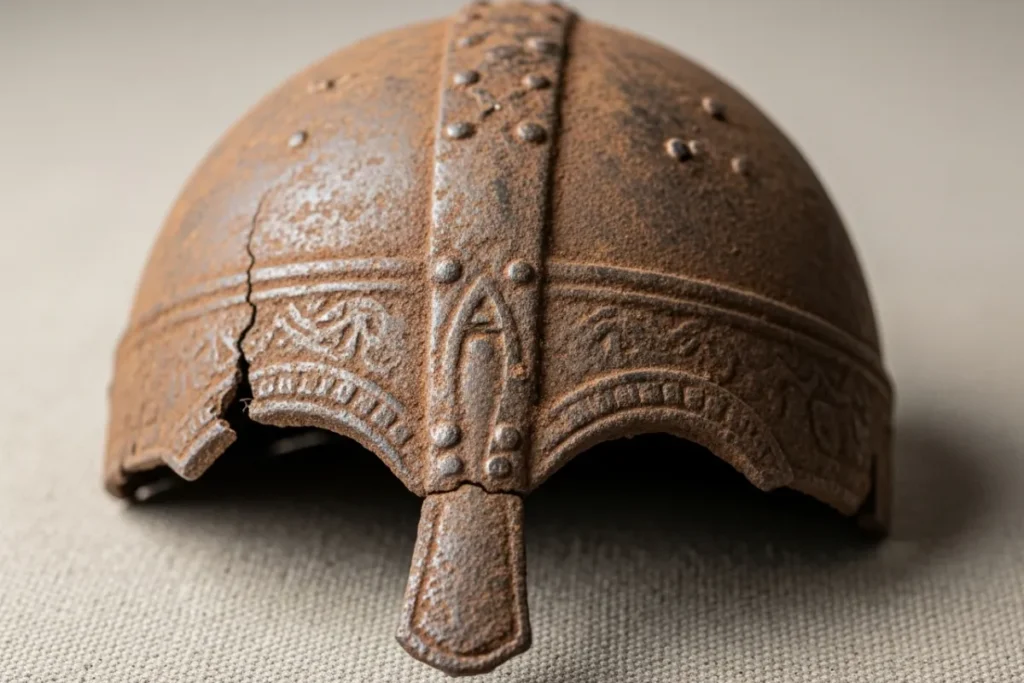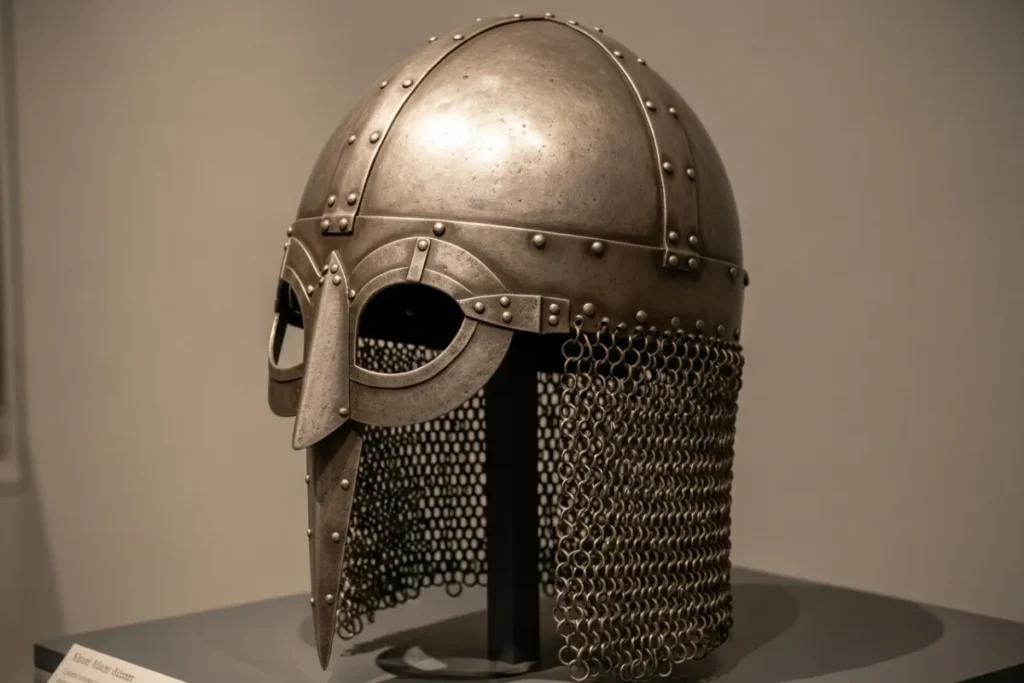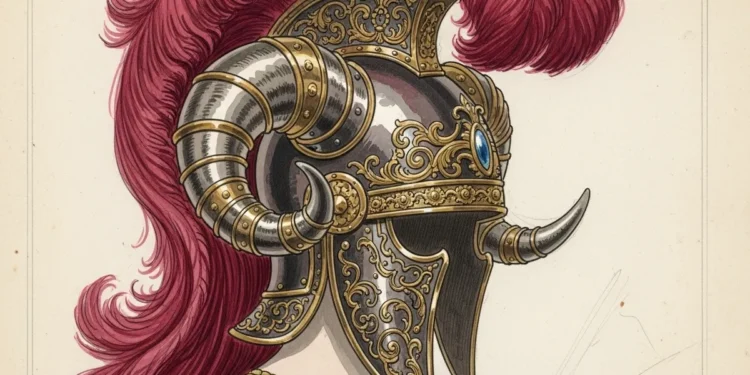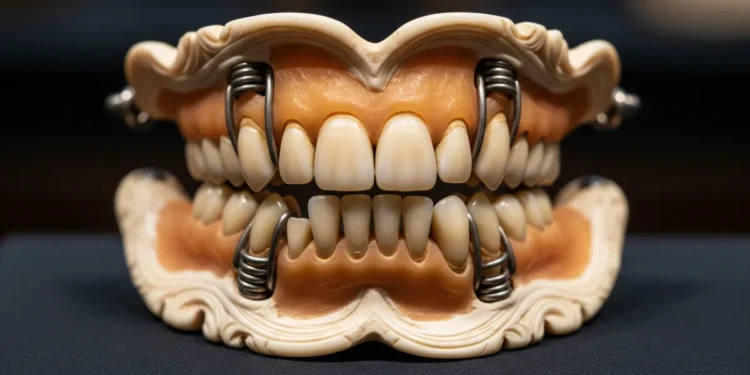Traces the Viking Horns Myth from 19th-century romanticism and opera costume design to modern media, explaining archaeological evidence against horned helmets.
Table of Contents
Introduction
The Viking Horns Myth is one of the most successful historical lies ever told. It is a powerful, instantly recognizable image: the savage Norse warrior, helmet-crowned with a pair of fearsome horns, charging into battle. This picture is so deeply embedded in our global culture—seen everywhere from opera stages and football stadiums to Hollywood films—that it feels like an unshakeable truth. Yet, it is a complete and utter fabrication, a piece of theatrical fantasy that has masqueraded as history for nearly 150 years. This enduring falsehood does more than misrepresent a piece of headwear; it fundamentally distorts our entire understanding of Viking culture.
The problem with the Viking Horns Myth is not just that it’s wrong, but that it’s lazy. It replaces a complex and sophisticated society of explorers, traders, artists, and lawmakers with a one-dimensional caricature of a brutish barbarian. This convenient stereotype, born from 19th-century romantic nationalism, has proven incredibly difficult to dislodge from the public consciousness. Every time a horned helmet appears on a screen or in an advertisement, the lie is reinforced, pushing the authentic history of the Vikings further into the shadows. The consequences of the Viking Horns Myth are a stark reminder of how easily fiction can conquer fact.
This article will dismantle that fiction piece by piece. We will begin by examining the modern pop culture stereotype and confronting it with the stark reality of the archaeological record, which reveals a conspicuous absence of such helmets. We will then trace the myth to its precise origin in the dramatic world of 19th-century opera before analyzing why this theatrical invention persists so stubbornly today. Finally, we will champion a more authentic vision of the Vikings, moving beyond the horns to embrace a history that is far more compelling than the myth ever was.
The Imagined Viking: Deconstructing the Modern Stereotype
Picture a Viking. The image that springs to mind is almost certainly a burly, bearded warrior, brandishing an axe and, most importantly, wearing a helmet adorned with a menacing pair of horns. This powerful stereotype is everywhere—from Hollywood blockbusters and Saturday morning cartoons to the branding for the Minnesota Vikings NFL team. It has become the default visual shorthand for Norse seafarers, so deeply ingrained in our collective consciousness that it feels like an indisputable fact. This piece of iconography is the very foundation of the Viking Horns Myth, a fabrication so successful that it has almost entirely eclipsed the historical reality of the people it claims to represent.
The persistence of this image isn’t accidental; it speaks to a deliberate romanticizing of the past. The horned helmet transforms the historical Norseman into a figure of fantasy, a brutish barbarian perfectly suited for epic tales of conquest and adventure. This depiction is psychologically potent, evoking a sense of wild, untamed savagery that is far more thrilling than the complex truth. The horns add a demonic, almost supernatural quality, elevating the Viking from a mere historical actor to a larger-than-life mythological creature. It’s this dramatic appeal that gives the Viking Horns Myth its incredible staying power in popular culture.
However, this romanticized vision clashes directly with a century of careful archaeological research. The central conflict of our analysis, and the core problem with the Viking Horns Myth, is that this iconic helmet simply never existed in the Viking Age. Not a single piece of evidence from a Viking settlement or burial ground supports the idea of horned headwear for combat. This glaring discrepancy between pop culture and the historical record forces us to ask a critical question: if the horns are a lie, where did they come from? Understanding this is the first step in rethinking the Viking Horns Myth and appreciating the authentic, and far more interesting, culture it obscures.

Horns of Contention: What the Archaeological Record Shows
When we turn from popular imagination to the hard data of archaeology, the Viking Horns Myth evaporates completely. Decades of meticulous excavations across Scandinavia and other Viking settlements have unearthed countless artifacts—swords, axes, ships, jewelry, and everyday tools. Yet, among this vast trove of material evidence, not a single Viking Age helmet adorned with horns has ever been discovered. The absence is deafening. For such a supposedly defining piece of warrior attire to leave no trace is not just unlikely; it’s a definitive archaeological statement against the horned helmet myth. The Viking Horns Myth is built on a foundation of nothing.
So, what did a real Viking helmet look like? The premier example—and the only complete one ever found—is the Gjermundbu helmet, discovered in a chieftain’s grave in Norway. Dating to the 10th century, it is a masterpiece of practical, effective design. Forged from iron, it consists of a simple bowl-like cap with a distinctive “spectacle” guard protecting the eyes and nose. There are no horns. Its purpose was purely functional: to deflect blows and keep its wearer alive in battle. From a combat perspective, horns are a fatal liability, easily snagged by an opponent’s weapon or used to wrench a warrior’s head aside.
The confusion that fuels the Viking Horns Myth often stems from a gross historical misattribution. Horned helmets were found in Scandinavia, but they belong to the Nordic Bronze Age, predating the Vikings by nearly 2,000 years. Artifacts like the Veksø helmets were elaborate, delicate creations likely used in religious ceremonies, not warfare. The conflation of these ancient ritual objects with Viking battle gear represents a fundamental misunderstanding of the timeline. This anachronism is a key pillar supporting the flawed Viking Horns Myth, blending distinct historical periods into a single, inaccurate tapestry.
From the Stage to the Page: The 19th-Century Invention of a Myth
If archaeology provides no evidence for horned helmets, then their origin must lie elsewhere. The birth of the modern Viking Horns Myth can be traced to a very specific place and time: the stage of the Bayreuth Festspielhaus in 1876. It was here that Richard Wagner’s epic opera cycle, Der Ring des Nibelungen, premiered, featuring dramatic costumes designed by Carl Emil Doepler. In a bid to create a visually striking and primal Teutonic world, Doepler outfitted the opera’s antagonists with horned headgear. This single artistic choice, made for theatrical effect, became the genesis of one of history’s most enduring falsehoods.
Doepler’s design did not emerge from a vacuum. It was a product of 19th-century Romanticism, a cultural movement that glorified the past and was deeply intertwined with rising nationalist sentiments across Europe. In Germany and Scandinavia, there was a fervent desire to construct a heroic, semi-mythological Norse and Germanic heritage. Historical accuracy was secondary to creating a powerful national narrative. The horned helmet was the perfect symbol for this new vision—it was dramatic, intimidating, and evoked a pagan wildness that suited the era’s artistic tastes. The Viking Horns Myth was born not from history, but from a need for a nationalistic fantasy.
Once this image was unleashed upon the world, it spread with remarkable speed. The opera’s influence was immense, and Doepler’s costuming was widely copied in illustrations for popular history books, poems, and paintings throughout the late 19th and early 20th centuries. Artists and writers, valuing drama over accuracy, adopted the horns as the definitive Viking look. This visual repetition effectively laundered the invention, transforming a piece of stagecraft into a perceived historical fact. The flawed Viking Horns Myth had successfully leaped from the stage to the page, cementing itself in the public consciousness for the next century.

The Myth that Won’t Die: Why Horns Persist in Pop Culture
Despite being thoroughly debunked by historians and archaeologists for decades, the Viking Horns Myth continues to thrive in modern media. From the classic 1958 film The Vikings to animated characters like Hägar the Horrible, the horned helmet has become a self-perpetuating cliché. Each new generation is introduced to this image through cartoons, video games, and advertising, reinforcing the inaccuracy. The myth has achieved a level of cultural saturation where its presence is no longer questioned; it is simply expected. This cycle of repetition ensures that rethinking the Viking Horns Myth remains an uphill battle against a deeply entrenched visual legacy.
The primary reason for this persistence is its power as a visual shorthand. For a filmmaker, advertiser, or costume designer, placing horns on a helmet is the quickest and most efficient way to communicate “Viking” to an audience. It requires no explanation or historical context. This convenience makes it an irresistible trope, even for creators who may be aware of the inaccuracy. The horns have become a brand identity, a universally recognized logo for a romanticized version of Norse culture. The immediate legibility of the symbol often outweighs any commitment to historical authenticity, making the Viking Horns Myth a practical, if dishonest, tool.
However, the consequences of the Viking Horns Myth extend beyond simple inaccuracy. By clinging to this one-dimensional, cartoonish image, we lose sight of the true complexity and sophistication of Norse society. The Vikings were not just brutish raiders; they were master shipbuilders, intrepid explorers, savvy traders, and creators of intricate art and literature. The horned helmet stereotype flattens this rich history into a simplistic caricature of barbarism. The enduring power of the Viking Horns Myth actively obstructs a more nuanced public understanding, proving that a convenient fiction can be more damaging than it appears.
Beyond the Horns: Embracing an Authentic Viking Image
Fortunately, the tide is beginning to turn. A growing movement led by museums, public historians, and documentary filmmakers is actively working to dismantle the Viking Horns Myth and present a more authentic picture of the Viking Age. Exhibitions at institutions like the National Museum of Denmark and the Viking Ship Museum in Oslo meticulously reconstruct Norse life based on archaeological finds, showcasing the real technology, clothing, and culture. These efforts provide a crucial public service, offering a direct, evidence-based counter-narrative to the fantasy. They invite us to look beyond the stereotype and engage with the Vikings as they were.
This push for authenticity is also making inroads in popular culture. Recent television series like The Last Kingdom and video games such as Assassin’s Creed Valhalla, while still dramatized, have made a concerted effort to depict Viking armor, clothing, and society with a higher degree of historical accuracy. These portrayals demonstrate that the truth is far more compelling than the cliché. An accurately depicted Viking—a skilled navigator, a pragmatic warrior wearing a simple iron helmet, a farmer, or a trader—offers a richer, more human story than the one-dimensional horned brute. This proves that historical depth and popular entertainment are not mutually exclusive.
What, then, is the future outlook for the Viking Horns Myth? It is unlikely that the horned helmet will ever be completely erased from the realms of fantasy and Halloween costumes, where it has become a permanent fixture. However, a crucial shift is underway. As accurate information becomes more accessible and authentic portrayals gain popularity, the horned warrior is increasingly being relegated to the world of fiction where it belongs. The goal is not to eliminate the fantasy, but to ensure it no longer masquerades as history, allowing a more genuine and fascinating image of the Vikings to finally take its rightful place.

Conclusion
We have demonstrated that the quintessential image of the horned Viking is not a relic of history, but an invention of the theater. The Viking Horns Myth has no foundation in the archaeological record, which offers a clear picture of practical, horn-free helmets designed for survival, not spectacle. Instead, its origins are rooted firmly in the 19th century, born from the dramatic flair of a Wagnerian opera and nurtured by a Romanticist desire for a mythologized past. This single, potent image was then amplified by illustrators and, later, filmmakers, until it became an unshakeable cultural fact.
The remarkable persistence of this falsehood is a testament to the power of visual shorthand. In a world saturated with media, the horned helmet became a convenient, universally understood symbol for “Viking,” sacrificing historical truth for immediate recognition. This self-perpetuating cycle, running through cartoons, advertisements, and films, has successfully drowned out decades of scholarly correction. The consequences of the Viking Horns Myth are clear: it has flattened a complex, innovative, and multifaceted culture into a simplistic and brutish caricature, robbing the Vikings of their true legacy.
Ultimately, the Viking Horns Myth teaches us a critical lesson about how we consume and perpetuate history. It challenges us to look beyond the convenient stereotype and question the images we are sold. The call to action, therefore, is one of awareness. By supporting media that strive for authenticity, engaging with the work of museums and historians, and consciously choosing to see beyond the myth, we can begin to reclaim the narrative. The real Vikings—the master shipbuilders, intrepid explorers, and complex people—are waiting to be discovered, and their story is far more compelling than any horned fantasy.








